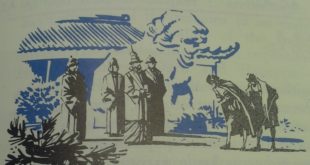In the same way that important ancient civilizations grew out of small beginnings in the valleys of the Nile, the Tigris-Euphrates and the Indus, so another great civilization of Early times — that of China — was cradled in the valley of the Yellow River. To be sure, China’s civilization did not commence as early as did Egypt’s, Mesopotamia’s, or India’s. The ancient Egyptian and the Mesopotamian kingdoms lost their power many centuries ago and early India never became completely united under one empire. China therefore has had a longer national life than any other ancient or modern state. It is the oldest of today’s nations. 1. How Did Early China Develop Under Various Ruling Families? China is dominated by three great rivers. China’s life, today as in olden times, centres in three river valleys. The great Hwang-Ho, Chinese for Yellow River, rises in the lofty mountains of Tibet. Winding its way slowly across the wide plain of North China, it flows into the Yellow Sea, so called because of the yellow soil the great river empties into it. Unlike Egypt or India, the North China plain has a climate like that of southern Canada, with warm summers and severe winters. The wind storms, disastrous dry spells and terrifying floods often bring destruction and misery to its inhabitants. Farther to the south is the valley of the Yangtze River. The Yangtze is one of the longest rivers in the world. In all, it flows nearly 4000 miles on its way to the sea. Still farther south is the Si, or West River. The climate of South China is warm and there is a heavier rainfall there than in North China. Many of China’s good ports are located along the southern coast. A Bronze Age civilization appeared first on the North …
Read More »The Growth of Civilization in Early India
Two hundred years before Columbus discovered America, a certain Marco Polo told strange, exciting stories to his friends and neighbours in Venice, a city in northern Italy. He had travelled, he said, to distant lands in Asia and had become rich. Europeans at that time had some general knowledge of eastern Asia and of its products, but Polo furnished detailed and colourful descriptions of magnificent cities, of strange customs and of powerful rulers who owned many palaces and lived in unheard of luxury. Marco Polo had visited the court of the khan, or ruler, of an empire that included most of east Asia as well as great islands in the Pacific and Indian Oceans. Polo had been made a public official. He had been sent on errands to the cold wastes of present day Siberia and the green Spice Islands where it was always warm. He had seen civilizations of many kinds — some primitive, some more magnificent than those in Europe. Marco Polo’s stories were so amazing that not until long after his death did most people believe them. “How,” thought Europeans, “could Asians have travelled so far on the long road from savagery without our help?” Today we know that Marco Polo’s stories were true, atleast in all important respects. We know that while Egyptians were building their pyramids and the Sumerians their temple towers in Mesopotamia, civilization was growing in India. We know also that while the Greeks and Romans were creating “the glory that was Greece and the grandeur that was Rome,” the Chinese were developing their own civilization and way of life. You will not find the empire of Alexander or the Roman Empire on a modern map of the world, as you know, but India and China still exist. Many changes have taken place …
Read More »

